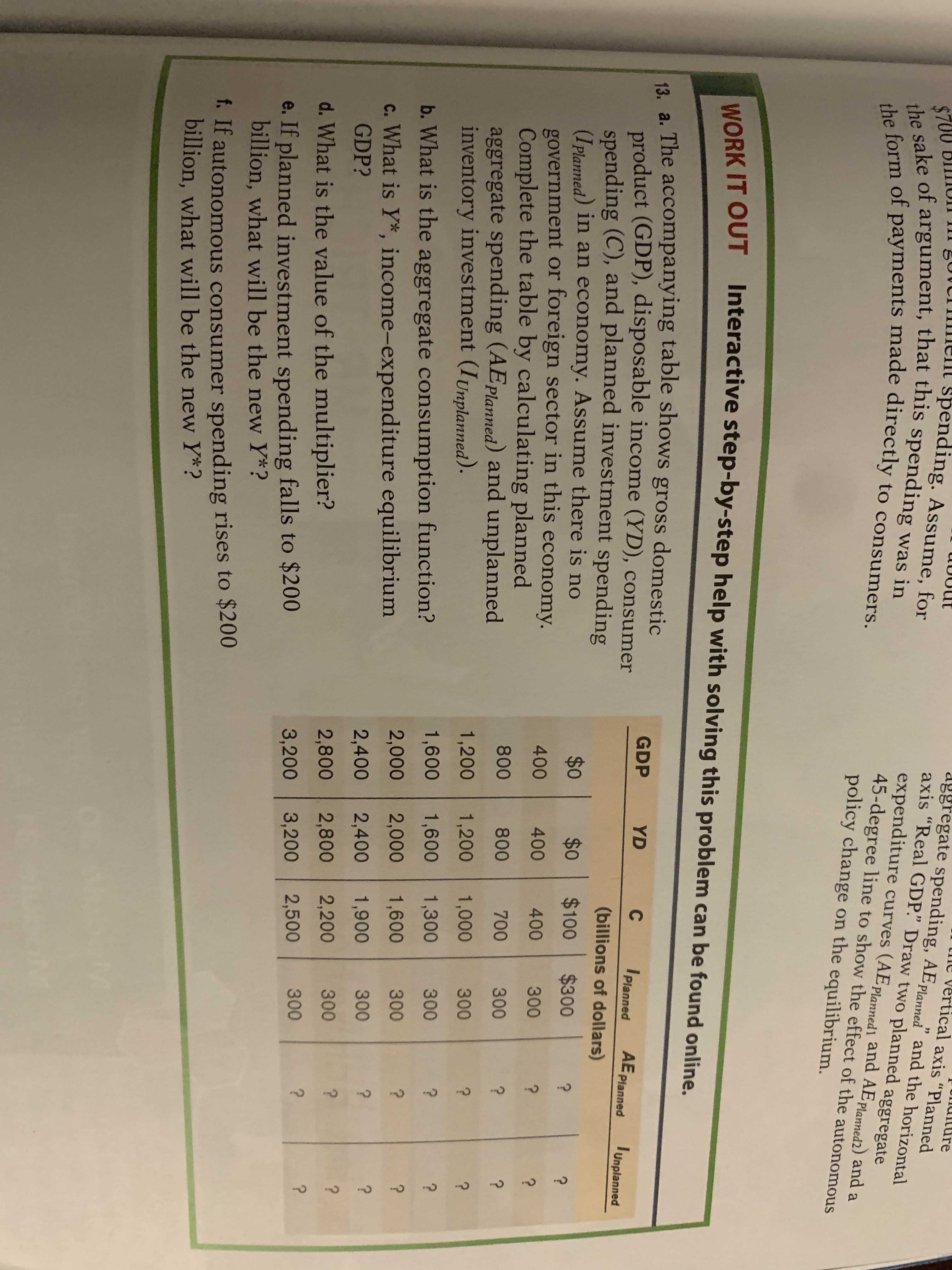ture vertical axis "Planned aggregate spending, AE planned and the horizontal Пim spending. Assume, for $700 BI the sake of argument, that this spending was in the form of payments made directly to consumers. axis "Real GDP." Draw two planned aggregate expenditure curves (AE planned1 and AEplanned2) and 45-degree line to show the effect of the autonomous policy change on the equilibrium. а WORK IT OUT Interactive step-by-step help with solving this problem can be found online. 13, a. The accompanying table shows gross domestic product (GDP), disposable income (YD), consumer spending (C), and planned investment spending (IPlanned) in an economy. ASsume there is no government or foreign sector in this economy. Complete the table by calculating planned aggregate spending (AEplanned) and unplanned inventory investment (IUnplanned). GDP YD IPlanned AE Planned lunplanned (billions of dollars) $0 $0 $100 $300 ? 400 400 400 300 ? 800 800 700 300 1,200 1,200 1,000 300 ? 1,600 1,600 1,300 300 b. What is the aggregate consumption function? 2,000 2,000 1,600 300 ? c. What is Y*, income-expenditure equilibrium GDP? 2,400 2,400 1,900 300 ? 2,800 2,800 2,200 300 d.What is the value of the multiplier? 3,200 2,500 300 ? e. If planned investment spending falls to $200 billion, what will be the new Y*? 3,200 T. If autonomous consumer spending rises to $200 billion, what will be the new Y*?
ture vertical axis "Planned aggregate spending, AE planned and the horizontal Пim spending. Assume, for $700 BI the sake of argument, that this spending was in the form of payments made directly to consumers. axis "Real GDP." Draw two planned aggregate expenditure curves (AE planned1 and AEplanned2) and 45-degree line to show the effect of the autonomous policy change on the equilibrium. а WORK IT OUT Interactive step-by-step help with solving this problem can be found online. 13, a. The accompanying table shows gross domestic product (GDP), disposable income (YD), consumer spending (C), and planned investment spending (IPlanned) in an economy. ASsume there is no government or foreign sector in this economy. Complete the table by calculating planned aggregate spending (AEplanned) and unplanned inventory investment (IUnplanned). GDP YD IPlanned AE Planned lunplanned (billions of dollars) $0 $0 $100 $300 ? 400 400 400 300 ? 800 800 700 300 1,200 1,200 1,000 300 ? 1,600 1,600 1,300 300 b. What is the aggregate consumption function? 2,000 2,000 1,600 300 ? c. What is Y*, income-expenditure equilibrium GDP? 2,400 2,400 1,900 300 ? 2,800 2,800 2,200 300 d.What is the value of the multiplier? 3,200 2,500 300 ? e. If planned investment spending falls to $200 billion, what will be the new Y*? 3,200 T. If autonomous consumer spending rises to $200 billion, what will be the new Y*?
Chapter11: Managing Aggregate Demand: Fiscal Policy
Section: Chapter Questions
Problem 2TY
Related questions
Question
Hello, I would like some help in another assignment (also step by step). Thank you!

Transcribed Image Text:ture
vertical axis "Planned
aggregate spending, AE planned and the horizontal
Пim
spending. Assume, for
$700 BI
the sake of argument, that this spending was in
the form of payments made directly to consumers.
axis "Real GDP." Draw two planned
aggregate
expenditure curves (AE planned1 and AEplanned2) and
45-degree line to show the effect of the autonomous
policy change on the equilibrium.
а
WORK IT OUT Interactive step-by-step help with solving this problem can be found online.
13, a. The accompanying table shows gross domestic
product (GDP), disposable income (YD), consumer
spending (C), and planned investment spending
(IPlanned) in an economy. ASsume there is no
government or foreign sector in this economy.
Complete the table by calculating planned
aggregate spending (AEplanned) and unplanned
inventory investment (IUnplanned).
GDP
YD
IPlanned
AE Planned
lunplanned
(billions of dollars)
$0
$0
$100
$300
?
400
400
400
300
?
800
800
700
300
1,200
1,200
1,000
300
?
1,600
1,600
1,300
300
b. What is the aggregate consumption function?
2,000
2,000
1,600
300
?
c. What is Y*, income-expenditure equilibrium
GDP?
2,400
2,400
1,900
300
?
2,800
2,800
2,200
300
d.What is the value of the multiplier?
3,200
2,500
300
?
e. If planned investment spending falls to $200
billion, what will be the new Y*?
3,200
T. If autonomous consumer spending rises to $200
billion, what will be the new Y*?
Expert Solution
This question has been solved!
Explore an expertly crafted, step-by-step solution for a thorough understanding of key concepts.
This is a popular solution!
Trending now
This is a popular solution!
Step by step
Solved in 3 steps with 1 images

Knowledge Booster
Learn more about
Need a deep-dive on the concept behind this application? Look no further. Learn more about this topic, economics and related others by exploring similar questions and additional content below.Recommended textbooks for you


Macroeconomics: Principles and Policy (MindTap Co…
Economics
ISBN:
9781305280601
Author:
William J. Baumol, Alan S. Blinder
Publisher:
Cengage Learning

Principles of Economics 2e
Economics
ISBN:
9781947172364
Author:
Steven A. Greenlaw; David Shapiro
Publisher:
OpenStax


Macroeconomics: Principles and Policy (MindTap Co…
Economics
ISBN:
9781305280601
Author:
William J. Baumol, Alan S. Blinder
Publisher:
Cengage Learning

Principles of Economics 2e
Economics
ISBN:
9781947172364
Author:
Steven A. Greenlaw; David Shapiro
Publisher:
OpenStax


Economics (MindTap Course List)
Economics
ISBN:
9781337617383
Author:
Roger A. Arnold
Publisher:
Cengage Learning